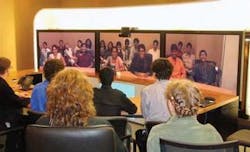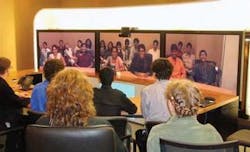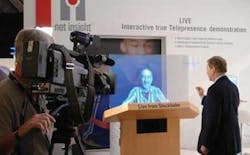by Meghan Fuller Hanna
Telepresence is defined as an immersive experience that combines high–quality audio and real–time, high–definition, life–sized video images on one or more screens. That type of studio–quality, instantaneous interaction does not come cheap—the typical telepresence conference room costs anywhere from $250,000 to $750,000—but more and more enterprises are justifying the expense relative to how much they stand to save in travel expenses. Even in the current economic climate, it's an easier sell than one might imagine.Videoconferencing is certainly not new; many enterprises have had video conferencing capabilities in place for years. But with previous incarnations, user satisfaction was notoriously low, reports Hugh McCullen, general manager of multimedia services at Nortel (www.nortel.com).
"When you would poll or survey [users of standard–definition videoconferencing], you'd come to find out that many are not happy with what they have," he says. "It's a cumbersome model to support. It's not typically something that can be integrated into their core networks. And the applications that they have running in the videoconferencing environment are not necessarily compatible with other applications outside their company. So the ability to conduct business–to–business communications with video is difficult," he adds.
Telepresence is designed to alleviate these concerns, from management and scheduling to interoperability and ensuring consistency of quality across all locations. Companies like Cisco (www.cisco.com), Digital Video Enterprises (www.dvetelepresence.com) and its partner Net Insight (www.netinsight.se), Polycom (www.polycom.com), and Tandberg (www.tandberg.com) offer everything from single–screen desktop units to immersive, multiscreen boardrooms, but all provide a fluid, visually and acoustically lifelike user experience.
Most telepresence rooms, for example, create the impression that everyone is assembled, face–to–face, around the same table in a single conference room, though, in fact, they may be halfway around the world.
Put another way, telepresence is "the use of telecommunications networks to create the illusion of presence," says Dan Lutter, vice president of strategic sales at Net Insight.
Today, most enterprises support their telepresence applications over the same network that carries their voice and data applications. While an underlying optical network is not absolutely necessary to support a telepresence offering, it certainly helps—especially since low latency, stringent quality of service, and high bandwidth are three key criteria.
Telepresence is trickier than a simple video transmission because it is bidirectional and will not tolerate any latency. Even a five– to ten–second delay disrupts a conversation. "If it doesn't get there in a half a second—the standard really is 50 msec—then you start talking over each other and it becomes very awkward," says Lutter. "So the first, strictest requirement is very low delay."
Quality of service, as measured by very low or zero packet loss, is also critical. Adhering to tight specifications for both jitter and wander can help mitigate the variable delay between packets. For example, Cisco recommends a peak–to–peak delay variation (or jitter) of <10 msec and packet loss at <0.5% to support its telepresence offering.
Because it is frequently an enterprise's C–level employees who host and attend telepresence meetings, rescheduling due to network downtime or unavailable bandwidth is not an acceptable option. As such, telepresence requires 99.999% reliability.
"[With] some manufacturers of products, if the network supporting [those products] dips below a certain level of quality, the system is cut off; it literally stops displaying the image," McCullen says. "That's the last thing you want to have in a videoconference, so you want to make sure that your network is robust enough to transport it."
The bandwidth required to support telepresence varies, often depending on the size and number of screens. But as everyone interviewed for this story confirms, telepresence demands a pretty big pipe. Initially, display devices fell in the midrange in terms of high–definition resolution, at 720p. But today's screens feature full–blown 1080p quality, and that does not come cheap from a bandwidth perspective.
While the typical voice call needs about 100 kbits/sec, the typical tele–presence session with 1080p resolution requires 15 Mbits/sec, or 150 times more bandwidth than the voice call, notes Cisco. Some telepresence offerings require bandwidth in the 20– to 25–Mbit/sec range. Erica Schroeder, director of marketing for Cisco's telepresence portfolio, confirms that Cisco recommends its customers allocate 5 Mbits/sec per screen.
"It is a lot of bandwidth," she acknowledges, "especially if you're talking about hundreds of units. But the good thing is, if you have to increase your bandwidth to handle telepre–sence, it runs on your regular network. So whenever you're not using telepresence, all that bandwidth is available for something else."
"Not everyone can afford 6 Gbits' worth of bandwidth," admits Net Insight's Lutter, "but I'll tell you, the Fortune 500 companies and their boardrooms can because they have to consider how much money it would save them in airline tickets alone. It would pay for the bandwidth and the equipment and services from a managed service provider."
Until about eight months ago, says Schroeder, she was fielding inquiries about telepresence as part of a "green" strategy as enterprises sought to reduce their overall carbon footprint. But last summer, when gas prices spiked, people began to focus on telepresence as an alternative to travel. "A lot of people are thinking, 'How do we continue to meet face–to–face without having to endure the cost of travel?' " she reports.
Adds Nortel's McCullen, "We're seeing customers who last year delayed or deferred decisions come back to us and say, 'We want to resurrect this discussion. And we want to move forward with something in Q4 because we absolutely are driven by reducing costs and enabling effective communications to happen now.' So the irony is that the financial environment and the status that it's in have a direct relationship to the increase in demand for these services."
Even the carriers are seeing an uptick of interest in telepresence these days. British Telecom and AT&T both offer intercompany telepresence services, for example, and Verizon Business last month teamed with Nortel to begin delivering telepresence service. Nortel offers a turn–key managed service and hosts multimedia network operations centers (MNOCs) around the world to facilitate inter–carrier transport and provide 24Ã�7 concierge–level support.
Confirms Roberta Mackintosh, executive director of advanced voice and unified communications & collaboration (UC&C) at Verizon Business, "We are seeing increased demand for video solutions for a variety of reasons, including the productivity and environmental benefits. Customer demand is absolutely one of the reasons why we've brought in this service."While Cisco's Schroeder says it's still too early to quantify how much business is being driven by the current economic climate, she is bullish on the technology's continued viability. "We're trying to essentially create on the telepresence network what we spent decades creating on the PSTN," she says.
"We are in essence creating a global, public telepresence network—but we're doing it faster. We're doing it in years, not decades."
Meghan Fuller Hanna is senior editor at Lightwave.
While popular use of telepresence today is mostly limited to boardroom–type scenarios, the technology lends itself to all manner of forward–thinking applications."We think the biggest market is going to be for the lower–end tele–presence systems," says Dan Lutter, vice president of strategic sales at Net Insight (www.netinsight.se), a Swedish company that offers telepresence equipment with partner Digital Video Enterprises (www.dvetele presence.com). "For instance, DVE has a desk with a screen on it, which is actually a telepresence screen. A call comes in, you press talk, and all of a sudden a picture comes up. So it's not just the Fortune 500. We see this really finding a market in every business segment everywhere collaboration is required. The next best thing to being there is having the best images that your budget can afford in lieu of a face–to–face meeting," he adds.
Taking that idea a step further, Lutter envisions telepresence kiosks popping up in retail stores, banks, hotels—anywhere people might require access to an expert. "We've actually had requests for kiosks where you could walk up and just touch a screen and all of a sudden you're talking to someone in real–time," he reports. "I see this applied just about anywhere people need help, in the moment, wherever they are, and they need an expert that doesn't happen to be there locally."
Cisco already offers what it calls Cisco Telepresence Expert on Demand, which facilitates high–touch customer service and point–of–sale services. In fact, the company itself uses virtual concierges in its customer briefing centers in lieu of live receptionists. The virtual concierge "can sit in one place and transfer all over campus," explains Erica Schroeder, director of marketing for Cisco's telepresence portfolio. "They can be available wherever needed, as fast as you can dial a phone. It's fun to try to keep up with them sometimes."
Cisco CEO John Chambers believes that someday, we will all have some form of telepresence in our homes. Yes, in our homes, confirms Schroeder, and she credits fiber–to–the–home initiatives like Verizon's FiOS for making that vision credible. "Having high–bandwidth out to the home allows you to start thinking about being able to pragmatically do this," she says. "When you start to have a footprint like that to the residence or office building, it makes a big impact on what you can do with such high–quality video and audio."
For his part, Lutter agrees that we have only seen the tip of the proverbial iceberg when it comes to telepresence.
"YouTube is unidirectional, but sooner or later, everything is going to be collaborative," he says. "You have your streaming video, but with this social networking phenomenon, everything is going to switch over to real–time collaboration. Whether it be on your cell phone with video images of the person you're talking to or whether you are on your favorite portal for social networking, it won't matter. People want to talk to other people, whether it's across town or halfway around the world," he says.



